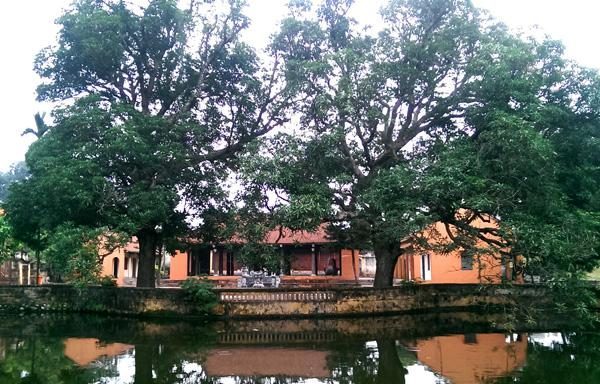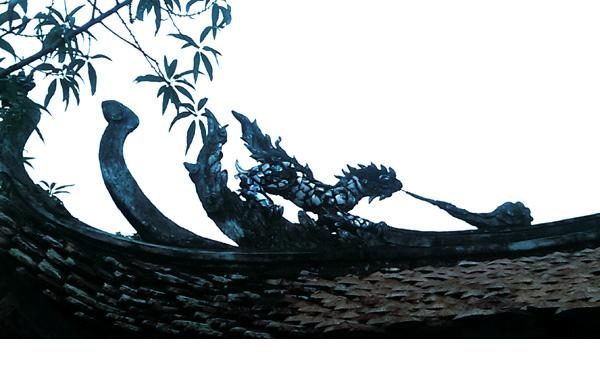Cu Son Trung Communal House, located in Yen Son Commune, Quoc Oai District, is 25 km away from the center of Hanoi in the west, commonly known as Cu Communal House. Despite aging and multiple renovations, it has remained the solemnity and 12 honours documents granted through the dynasties.

Cu Son Trung communal house historic monument
The communal house was built in the 16th century in the J-shaped style. As a whole, it is a large communal house with the gate, the yard, Dai Bai house, Trung house, Thuong house and two left and right rows of houses together with Lao lake and Cha lake outside. Cu Son Trung communal house is the place to worship General Pham Tu – the most meritorious person with Ly Bi attacking the Northern invaders to establish independent state Van Xuan in the period 541-545. The historical book wrote about him as follows:
He was famous in the early stage of his heroic life.
He went long miles in the frontier with the blessing
The old place is here – mountain and river soul
Ho dynasty horses do not dare to run in the green field.
(Thoat Hien)
These poem lines praise General Pham Tu not only for his high virtue but also as a national hero. The story is that, in 541, he with his soldiers expelled the Liang invaders from the country. In 543, when Chiem Thanh troops invaded, only once he came out he was able to disperse the enemy. With such great merit, the King gave him the title of Phuc Man and allowed him to marry Princess Ly Nuong Phuong Dung. Then he was appointed as the chief of the mandarins and named after the king’s surname as Ly Phuc Man. In 545, the Liang enemy continued to bring eighty thousand soldiers to our country again. During the war, despite his severe injury, he remained firmly the spirit of a general when riding alone to the base with traces of blood throughout a series of 74 northern villages.
The rectangular pillar gate is decorated with traditional patterns and four phoenixes on its top and extruded four spiritual animal motifs on its lower part and pairs of parallel sentences on two sides of the pillar body. Each side has an auxiliary gate with a stacking roof which is wide enough for one person to pass through with a vehicle. Connecting to the gate is a large wall system covering the campus of the communal house. Stepping through the gate is a large space paved with bright red bricks – the yard for ceremonies, festival, and meeting in the old days.
Cu communal house is also special and strongly attractive for its system of pillars as well as columns made of stone (Trung house), including 18 sophisticatedly carved green stone columns with diameters of 25-30 cm. Trung house has still remained the door system for all five sections with a total of 22 boards numbered from left to right and high thresholds requiring people to lift the feet to step over.
The communal house has a shoe-shaped tile roof and a boat-like curved roof porch, on the top of which are ceramic unicorn statues. On the top of the house roof is the lively and majestic statue of “two dragons see the moon”. Dragon statue is quite simple with a sharp sparse beard and short and fan-like mane. The dragons’ body is long and soft.

The firing unicorn on the roof
Dai Bai is built on the higher foundation than the yard with steps to access. Generally, it has five sections, high pillars and a firm frame to create a spacious space. Here is the storage of the dragon boat for the festive season, rowing on Cha lake to singing – a beautiful cultural feature of Cu villagers. Due to disadvantageous events, in 2004, people in and outside the village together contributed to the reconstruction of Dai Bai house with the same appearance. Trung house is separated from Dai Bai house by a narrow red-brick yard, where many of the historic worshipping items are displayed. With the three-section and 2-sideway structure, the main section is for the altar, with the board hung on the top with the line: “Human needs to be faithful and keep his own honour”.
On the pillars are the pairs of parallel sentences. Each side has a solemn set of swords and a pair of wooden cranes standing on the back of turtles facing each other. Two sections next to the main one display two gold red painted palanquins and some items such as drums, bronze gongs, and flags. The frame and support are made of solid ironwood with impressive dragon textures.
Finally, Thuong house has the similar structure to that of Trung house with blue stone boards, pillars and columns, but there are only 3 sections roofed with tiles with a pair of wooden horses inside. In the middle is the altar with incense burners, cups, and flower vase and curtains on the top. Innermost is the throne of the village’s god.
With the pride of the countryside witnessing a heroic period of the national hero, Cu Son Trung villagers built the communal house to worship him as the village’s god. Every year, on the 10th of lunar March, the villagers hold a festival to commemorate his merit as well as to wish a good harvest year.
On March 23rd, 1993, Cu Son Trung Communal House was granted by the Ministry of Culture the “National Historic, Cultural and Architectural Monument” Certificate.
Le Hai (HNP)
